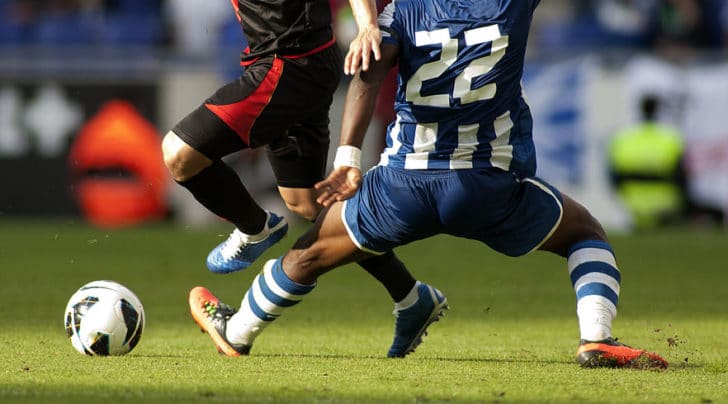
A bucket handle meniscus tear is a unique type of meniscus tear. Bucket handle meniscus tears are more common in younger athletes. They can occur in older adult athletes too, but most bucket handle meniscus tears occur in people under 35 years of age. A bucket handle tear is unique because the entire meniscus tears, flips over and becomes stuck in the middle of the knee joint.
It is essential to treat these tears early because they are very large tears. A bucket handle tear also “locks” the knee. That means that you are not able to fully straighten the knee. A bucket handle tear will usually not go back into its normal position on its own. It often needs our help. Let’s dive deeper.
The majority of these bucket tears can be fixed or sutured back together. In addition to being large, the torn part tends to flip over on itself and become stuck in the middle of the knee joint. If the meniscus flips over, you will find it painful to walk, and it can make it impossible to straighten your knee fully.
A meniscus is a c-shaped disc. We have two menisci within our knee, the medial and the lateral meniscus. A meniscus functions as a shock absorber. The meniscus serves a vital purpose by cushioning our knee when we walk, run, or play. If the meniscus tears, then that support or protection is lost, and osteoarthritis can occur.
What Is A Bucket Handle Meniscus Tear?
As you can see in the above picture, there are many different types of meniscus tears.
Bucket handle tears are most common in young athletes. The injury is usually non-contact and involves twisting or pivoting. Many athletes are injured in the same way.
They plant their leg to twist, pivot or change direction. They almost always feel a pop when the meniscus tears. Most patients with a large meniscus tear, such as a bucket handle or flap tear will develop significant swelling or bleeding in the knee joint.
The injury mechanism for a bucket handle meniscus tear is very similar to the injury mechanism which can create an ACL tear or a patella dislocation. When we see you in the office we are usually able to tell by our examination alone whether or not you have injured your meniscus, ACL or patella.
On examination in our office, we will not be able to straighten your knee, and you will have joint line tenderness. That means that you will have pain when we touch along the area where the meniscus usually attaches to.
When a bucket handle tear occurs, the meniscus supports, or the ligaments that hold the meniscus in place are torn. Without the support that keeps the meniscus in place, the meniscus can flop over like the handle on a bucket. When the meniscus flips over, it becomes stuck in the middle of the knee joint.
That results in a loss of motion because the meniscus is physically blocking you from fully straightening your knee. If you lose the ability to straighten the knee fully, then you have a “locked knee.” Many people with a locked knee are found to have a large piece of the meniscus which has flipped into the middle of the knee joint.
What Symptoms Does A Bucket Handle Meniscus Tear Cause?
Bucket handle tears of the meniscus tend to cause significant swelling and pain when they initially tear. After the initial swelling goes down, you will usually find that you can not straighten the knee. This is what we refer to as a locked knee.
That’s because the torn bucket handle meniscus tear is stuck in the center of the knee and is physically blocking the knee from straightening. Because of the loose piece of meniscus, you will notice a lot of popping, and you will have the sensation that something is stuck deep inside the knee. The knee feels very abnormal.
Many patients with a bucket handle meniscus tear will also complain that the knee feels loose or unstable. They will notice a lot of clunking or catching too.
How Do We Diagnose A Bucket Handle Tear?
A bucket handle tear is not a challenge to diagnose. Your story, as well as our physical examination, will usually raise our suspicion that a large meniscus tear exists. An MRI is usually necessary to confirm whether or not a complete meniscus tear is present. In addition, the MRI will show us if the meniscus is flipped over or if there is a large loose piece of meniscus stuck in the middle of the knee.
How Is A Bucket Handle Meniscus Tear Treated?
Most patients with a bucket handle meniscus tear will need to be treated surgically via an arthroscopy. During an arthroscopy, we put a small camera in the knee to see the meniscus tear.
Do you have questions regarding an Orthopedic injury or longevity?
Do you want to talk to an expert who can listen to you for 45-60 minutes and explain the options in detail?
Dr. Howard Luks offers remote guidance sessions to review your X-ray or MRI images and explain your options.
Dr. Luks has also received hundreds of requests for educational sessions on the topics discussed in his book, Longevity Simplified.
Again, these tears are usually flipped over and stuck in the middle of the knee. The first thing we do is to push the meniscus back into its normal position. Then we look at the tear and see if it is repairable. Most bucket handle tears can be repaired by placing sutures or stitches in it.
A repair is strongly preferred over removal of the torn piece. We want to try and repair these tears. If we cannot fix it and we remove the bucket handle tear, you will be at high risk for developing osteoarthritis.
While many bucket handle tears can be repaired, others cannot be repaired. The decision of whether or not it can be fixed is made at the time of surgery when we are looking at the meniscus. If the meniscus has a good chance of healing, then we will proceed to repair it. If we do not believe that the meniscus will heal, then we need to remove the torn piece.
Recovery After A Bucket Handle Meniscus Tear
After surgery, you might be on crutches for a short while to protect the internal stitches and allow the meniscus to heal. After therapy and waiting enough time for the meniscus to heal, many athletes can enjoy a full return to activities after repair of a bucket handle tear. Return to sports after the repair of a bucket handle meniscus tear can take 4-6 months or more.
Can the meniscus tear again? Yes, it can. This is not common, but it does occur.
The majority of people who have a bucket handle tear will go on to lead a normal life if the tear is promptly treated, repaired and if the meniscus heals. Unfortunately, there is very little chance that non-surgical treatment will work for these large unstable tears. The timing of meniscus surgery is important too. A bucket handle tear should be fixed within a few weeks from the time the diagnosis is made. When the meniscus is flipped over, it is at risk of losing its normal shape and being torn more. If the meniscus loses its shape or tears more, then it may not be repairable.
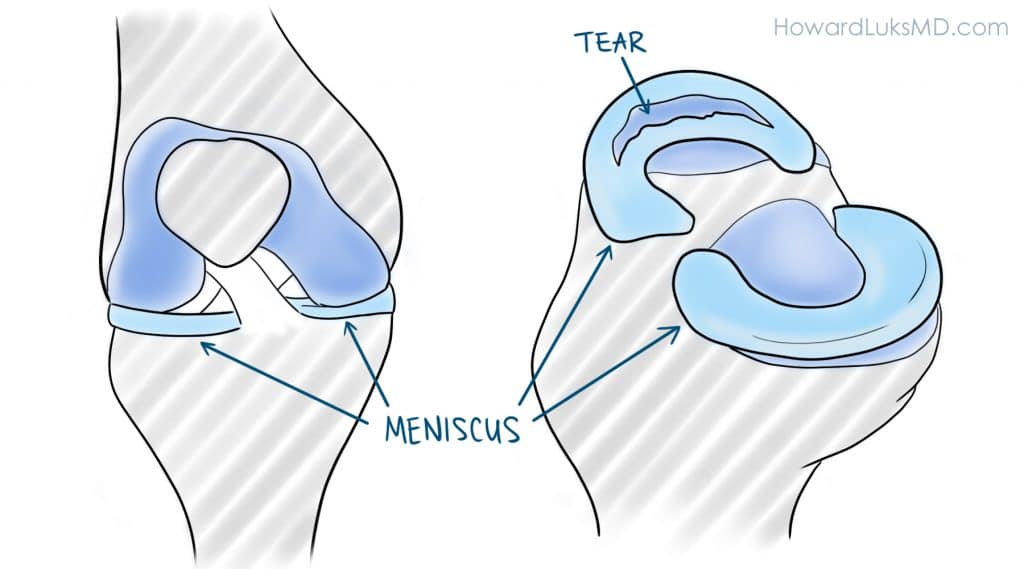
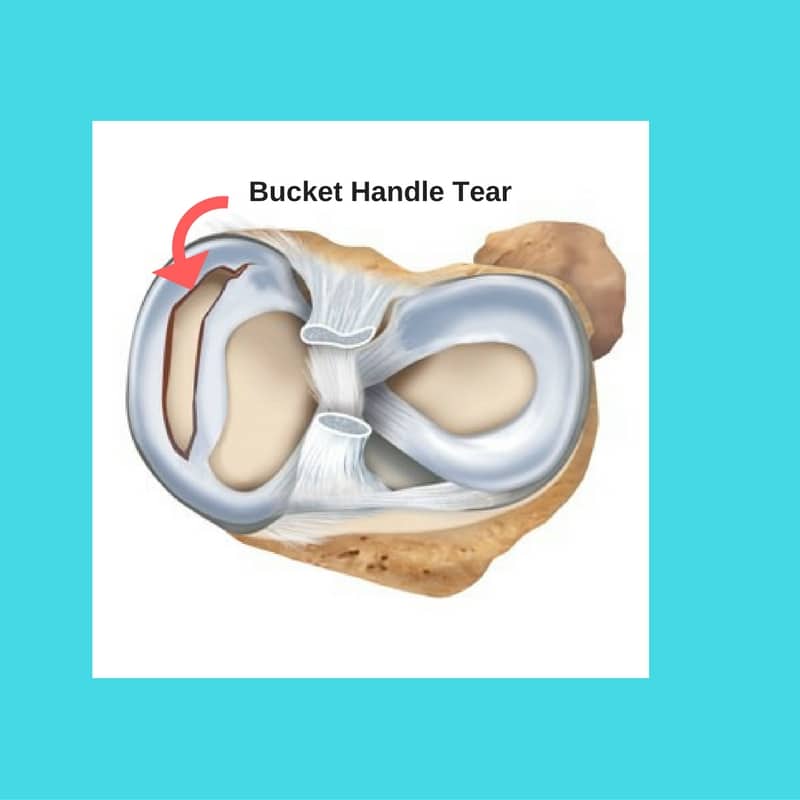
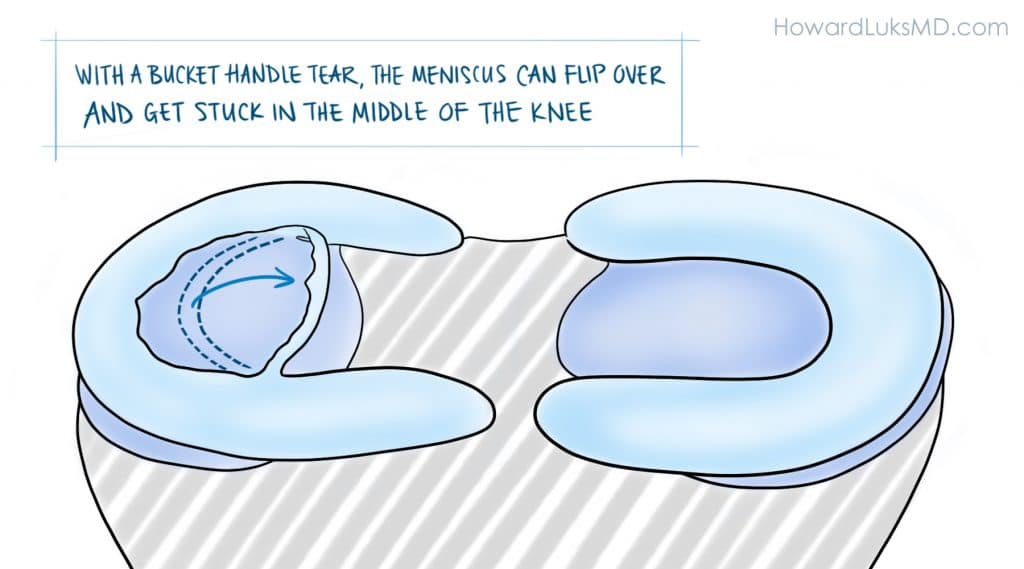
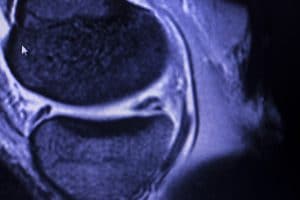
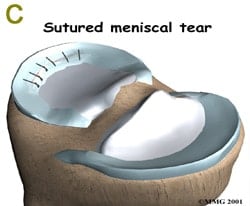
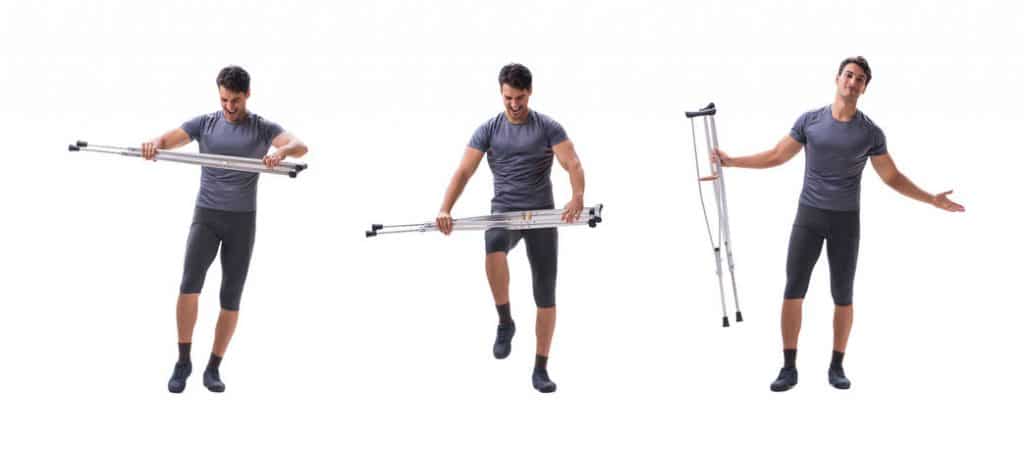




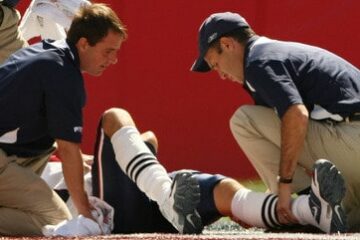








Rob
Hi Doctor Luks,
I’m an active 48 yr old male. I had a bucket handle tear on the medial meniscus in 2017, and got by for 2 months with minimal discomfort before I saw s surgeon because the MRI showed a tear. He didn’t inform me I had a bucket handle tear at the time (though it was noted on the MRI I later found out) and scheduled me in for surgery telling me he’ll cut it out and ill be good to run around and do whatever sports I want after. After surgery he informed me he’d removed 60% of my meniscus and of course I never ran again but could walk, cycle and get by. I later asked why the meniscus wasn’t repaired and he said the meniscus has no blood supply and rarely do repairs last.
Fast forward 2 years and same surgeon recommended a microfracture surgery and guaranteed it’d get me back to better levels of activity. Naturally I agreed but this procedure wasn’t done due to advanced arthritis and articular cartilage loss and instead he did a debridement, shaving away more cartilage and meniscus. I would never of agreed to this was not the discussed procedure. I now have difficulty even walking, I cannot do my job and my quality of life has gone downhill.
I’ve just had stem cell treatment and hoping that provides some relief. In the near future I’m considering Osteotomy with cartilage regeneration and a meniscus transplant. In your professional opinion is this a good option?
Thanks
Rob
Lisa Bailey
Hello. I felt a pop in my knee and then a strong painful pull up my thigh. I now cannot extend my leg out. It feels stuck and I have no pain sitting but a lot of pain walking.
I see the surgeon Monday morning but my question is this:
If my leg won’t straighten out how am I to get through an MRI? I can’t imagine being forced to straighten it when it doesn’t straighten.
Thank you for your time,
Lisa
Hi lisa… you can have the MRI with the knee partially bent.
Carla
My 17 year old son had a bucket handle lateral tear from playing basketball. He had the surgery a few days later where it was repaired successfully. It has been 5 1/2 weeks now and he feels great. HE can fully extend his knee, run, etc. He wants to return to play basketball now for his high school team. Surgeon says it will be 4-6 months regardless. Is this normal protocol? If he feels 100% and wants to return in a few weeks is that reasonable? Are there specific tests which he can do to get cleared?
Thank you in advance!
Your surgeon is correct. It takes many months for the meniscus to develop the strength it needs for a return to sports. Returning to sports too soon risks having a recurrent tear.
Urmila M.
Hello Doctor,
I’m a moderately active 37 year old. Earlier this year (Jan) I hurt my right knee at the gym. I landed weird on the right foot when jumping off a box and my knee felt stiff. I saw an orthopedist a week later and by then I couldn’t even point where it hurt.
Fast forward to nine months later, and I hurt the same knee while playing tennis. I felt a ropy pop in my right knee and felt intense pain. I immediately iced it and got another appointment a week later. This time the knee still hurt and the doctor was able to pin point the area and immediately diagnosed a meniscus injury. Here’s the MRI report: TECHNIQUE: Routine MRI images of the right knee joint FINDINGS/CONCLUSION
1. Anterior compartment: Mild lateral patellar subluxation is present, with no patellar tilt. The patellar and trochlear cartilages appear normal. The patellar tendon is mildly elongated with relative high patellar position (mild patella alta).
2. Fluid collections: A moderate joint effusion distends the suprapatellar pouch. No popliteal cyst.
3. Ligaments/tendons: The anterior and posterior cruciate ligaments are intact. The medial collateral ligament and lateral collateral ligament complex are intact. The popliteus tendon and iliotibial band appear normal.
4. Medial meniscus: A complex, bucket-handle tear extends through the anterior horn, body, and posterior horn with a moderate inward displaced bucket-handle fragment which extends over the medial tibial spine.
5. Lateral meniscus: No tear is identified.
6. Osseous/articular: No arthropathy, osteochondral defect, stress injury, or osteonecrosis. No suspicious bone lesion.
It has been about a month since the injury and now I barely feel any pain. I am able to extend my knee fully and have been walking without a limp or any pain.
Can I leave the knee alone without any surgery?? Is there a chance my meniscus will heal on its own? I’ve started taking turmeric and collagen peptides in the hope that it will heal! Or is surgery the only fix? Any insight/advice will be much appreciated. I’m a mom of two active boys and I’d love to get back to my active lifestyle. Thanks!
HI Urmila… It is unlikely that this type of tear heals on its own if it is displaced. That being said, obviously, some people have very little pain despite having a displaced bucket-handle meniscus tear.
Good luck to you.
Urmila M.
Thanks, I might get the surgery after the recommended 3 weeks of PT. Surgery scares me. Particularly the pressure recovery may put on my family. And the fact that I may lose more meniscus and that may lead to early issues in that knee.
Nicolas
Good day Mr Howard,
I’ve injured my knee about 2 weeks ago. I did MRI couple days after.
I have a bucket handle meniscus tear , the doctor suggested surgery but he couldn’t confirm me to either do the repair or just remove the piece.
I booked the surgery but few days before the surgery I cancelled it out of fear and also considering that I am already able to almost fully extend my knee , able to walk normally too and no pain overall , just a sharp pain on my knee for few seconds sometimes .
I’ve being doing exercises to keep the affected leg strong and stay as healthy as possible.
I’m 30 years old and very fit , I wouldn’t consider the surgery unless is really necessary ,the fact of having a 25% chances of a post surgery tear also set me off too .
What are your thoughts ?
If I’m not in pain or real discomfort after 2 weeks should I still do it ?
Also , the doctor just examined me in 2 occasions for less than 5 mins .
I don’t think rushing into a surgery it’s always the best option .
I appreciate the fact that you take time to answer everyone.
Thanks in advance
HI … A repair is certainly preferred to removing the torn piece. I am able to repair over 95% of bucket-handle tears. I would hope that most sports docs would do the same. I cannot advise you on whether or not to have the surgery… but it seems like you should consider a second opinion to find a doc who you have a good rapport with.
Sol Karakan
Hi Doc!
I have a bucket handle tear on my left knee that I injured playing beach volleyball august 29. It locked my knee completely at the spot. Next day, I saw an orthopedist and he unlocked my knee and with lots of icing and taking care i was able to move again in 10 days. That made me act cocky (and very stupid) and I played ball again. That was right in the 2 weeks range. After playing 6 hours, end of the 6th hour, it locked again. My MRI results (which I have sent to multiple doctors and got results back, doctors recommending surgery) are the results from the previous injury. I have not gotten MRI after the second injury (which is 2 weeks ago from now, which I am following the same healing pattern but definitely staying away from sports). Now… Today, I met with an orthopedic surgeon.. He just spilled the grave news. Those news that 3 people above me mentioned about. He said, if he can’t repair it, he will remove it. That is simply my biggest fear, and reading the lines of the others, wanted me to write this down for the future fellows reading this.
Now.. coming to the crucial point. How hard will this surgeon try to repair it? Is it simply a yes or no decision once the micro camera is in my knee? Or is it a decision that doctor freely takes? Is taking the whole meniscus easier compared to trying to repair it? I’m simply scared, scared a lot that the surgeon I have met with today seemed like he did not care at all about my future sport life, which is basically my whole life.
Thank you in advance for your response!
Hi Sol… Most bucket handle tears are repairable. On rare occasion, they are not repairable. In my experience, I have rarely had to remove them over the last 26 years. Stick with the doc who seems to favor repair over removing it.
Laura Brown
I had a bucket handle meniscus injury in February. My surgery was one and a half month later. My knee was locked and bent that whole time. After the surgery and 2 months physical therapy, I still had poor range of motion, but could walk with a limp. My surgeon then did a knee manipulation on me 3 weeks later. It’s been 10 days since and my range of motion has not improved and I still walk with a limp. I’ve gone to pt daily and do my home exercises. My knee is so stiff and it still hurts too. I feel like I’m ever going to recover from this and it’s extremely discouraging. What are your thoughts? Will continued physical therapy and home exercises (including recumbent bike) help me? Is there anything else that can be done for me? I just want to get my life back. Please help. Thank you.
A second opinion is probably worthwhile.
Patrick
Hi Doctor,
I’m a 38 year old highly active male and I injured myself during sport 8 weeks ago.
My MRI report noted, “Bucket-handle tear of the medial meniscus with central displacement of the bucket component. There is horizontal tear involving the residual slightly small meniscal rim.”
My worry is that my injury occured about 8 weeks ago. My doctor’s office and insurance company have been slow to move and I’m worried that I am now past the point where a repair would be successful.
Do you have any idea what the likelihood of success is this far out?
Thank you for reading.
Hi Patrick… We have successfully repaired tears that have been present for many months. It all depends on what the meniscus tissue looks like when we put the camera in the knee. If the tissue is deformed or degenerative we will not be able to repair it.
Good Luck
Rams
I had an accident at my dance class almost 2 months ago. Initial swelling / pain was gone in a week. Since I could not get my knee back to its routine my ortho suggested an MRI. The results looks as below. I’m not in a constant pain, I wear knee braces, but I cannot stretch my knee, run or get back to my dance yet. The doctor suggests a surgery. But I would like to make sure I ask enough questions before getting in. What are the things that I need to consider before making sure surgery is the only option?
Report as below:
There is a bucket-handle tear of the medial meniscus; a large medial meniscal fragment has flipped
laterally into the intercondylar notch, while remaining attached to the medial meniscus at the
anterior and posterior roots.
The lateral meniscus is normal in signal and morphology.
The anterior cruciate ligament is abnormally sagged in contour; this appearance is indicative of at
least a partial-thickness tear of the ACL, with a proximal full-thickness component not excluded.
Thanks a lot!
Bucket handle tears are best handled by repairing them. That means putting them back into their normal position and putting in a number of sutures or stitches to allow it to heal. You should ask how many of these your surgeon repair with stitches. Some doctors will simply take the torn piece out. So clarify that they will attempt a repair and that they perform enough of them to be comfortable doing it.
Rams
Thanks for your quick response Doctor. My ortho says he most probably is going to remove the torn part and suggests a repair of ACL along. Can this not be done by physical therapy and rest? Reason I’m asking is, invariably the long term impact is early onset of Arthritis and slow recovery.
Rams
Frankly, I’m not convinced that surgery is the only option. It seemed the doctor was biased with surgery. Is there a way for you to review the results?
LG
I had a hiking injury in the 3rd of NOV, couldnot continue on the mountains and carried by helicopter . I did an MRI and the report is as below, when a first Dr. saw me, he wanted to operate right away and mentioned he will try to repair if he could not he will cut it. searched over the internet, that i can wait a bit and see how it will heal on itself and with PT I rested iced it and it is getting better, when I load it a bit it hurts so i reset again, i thought I am rushing it as i started walking, and doing stationary bike and some stretching with 7lbs of weights. Not sure I am doing the right thing , or I am blowing my chances forgetting it repaired if it could . All i honestly want is to heal or repair and avoiding survey that will risk cutting my meniscus as it is too early (39yr) for me and I love hiking alot. should I continue or look for alternative to surgery ( pbr, stem..etc) are those just for pain or help healing. Also, is the only option is cutting? if they cannot repair , why they do not leave it, my guessing cutting will make things worse on the future, non? I am working on my nutrition as well and eating food full of collegian , protein , vitamins and hydrating my self. Thanks to let me know the right path as i donot want to wait long or i lose my chances or any possible repair if any. Adding searching shows alternative surgery options are not everyone, would it be OK for me?
=====MRI Report=======================
ACL: intact
PCL: intact
Medial Meniscus: Intact
Lateral Meniscus: Bucket-handle tear of the lateral meniscus with displacement of the lateral meniscal body posterioly and extending into the intercondylar notch.
MCL:intact
Lateral collateral ligament complex : Lateral collateral ligament complex is intact. There is extenive increase T2 signal surrounding the lateral collateral ligment complex, reactive to the underlying lateral menisoal abnormality.
Joint: Large Joint efussion. Not malalignment
Soft Tissues: Mild edema is present suboutaneous soft tissue . No Baker’s Oyst. Moderate edema is present about the lateral knee. Moderate strain of the short head of the biceps femoris.
Osteochondral strcutures: No actue fracture or osteonecrosis. Partal-thickness cartilage loss medial patellar facet extending to the median patellar ridge. Cartilage signal is otherwise intact.
IMPRESSION:
Bucket-handle tear laterl meniscus
Mild patellofemoral compartment loss
Medial meniscus, cruciate and collateral ligaments are intact.
Moderaye strain of the biceps fermos muscle in the distal thigh
Large joint effusion
If the torn part is not displaced and if it returned into its normal position then there is a chance of it healing.
If the torn part is displaced, then it is very unlikely it will heal on its own.
The best chance of a repair is before the torn piece loses its shape and consistency or firmness.
Most complete bucket handle tears can be repaired, however, we do encounter some tears that are not repairable.
There are some of us who might consider a meniscus transplant (especially for a lateral meniscus) , if the torn piece needs to be removed and if the person develops lateral pain after removal.
Good luck
LG
Many thanks for reply. I just came from another Dr. he mentioned from the MRI he cannot tell if the meniscus is repairable or not. The only way he would tell is when I am in surgery and then I will not have a say and he will go and and trim it if needed. I understand , where he is coming from and if it is displaced, then it is displaced and it has to be restore to it original position anyhow. But why I cannot have a chance of repair, even if the cut is not near the blood vessels and see if the body will heal by itself. I do not mind the long wait after the surgery to give it time to heal or longer PT period. I guess saving the meniscus will benefit me on the long run. Can I send you the link for the MRI itself and if you think that this is a repairable or not, I would prefer that you operate on it. I live in VA and this should be a short fly. Basically, I do not want to leave any chances for trimming it if it can be saved. Thanks in advance
HI ..
My assistant can be reached at 914-789-2735.
You can send the link to her and we will see if we might be able to give you a better idea regarding repairability of the tear.
Cameron Watson
I had surgery 3 weeks ago for a MCL bucket tear. I can fully extend my knee when sleeping and currently walk on it. However when standing I still have a slight bend in the knee.. is this normal ? My doc said I shouldn’t rush it because it could potentially hyper extend.
Any info will help thanks.
HI Cameron… for many people it can take a while to get back full knee motion after a meniscus repair. Good luck
Brandon
Hi,
I am concerned. I just got my bucket handle tear repaired. It’s been 7 days post-op and I still feel its impossible for me to walk or bare weight on it. Its crazy because i just came from my doctor and he said he is used to seeing other patients come in walking 2-3 days after their surgery. Discouraging to feel that my progress is slow. It just seems so far out of reach to even walk on my leg since ive lost muscle in it from being off of it for almost a month now. What do you think?
Best,
Brandon
Hard to say Brandon… Many people do recover quickly. Some recover much less rapidly.
Wish I could say more…
Trevor Mayfield
Hi Dr!
I am a 27 year old personal trainer with a lateral bucket tear. I don’t have much pain, only tightness in my lower quad, and occasional swelling there. I can do barbell squats and play soccer or whatever sport I’d like. But I do have some limitations in my mobility, mainly in my deep squat and kneeling sitting on my heels. I’m seeing some articles saying I’ll be fine, and some make me wonder about my later years. Should I get it removed?
We try very hard not to have to remove these large pieces of meniscus. That might contribute to the onset of arthritis. We prefer to fix them by suturing the pieces of the meniscus back together. I would gather a few opinions before moving forward with surgery.
Martin Creel
Hello Dr. Luks and thank you for the great video and article. Your page has lifted some of the mystery of me knee pain.
I’m a 51 year-old male in good shape. My knee locked when I was a kid and I had surgery. A recent MRI revealed that most of the medial meniscus was removed (apparently this was just before arthroscopic surgery). My current surgeon recommended PT, strengthening the quads, which I have been doing consistently for six months. It has helped somewhat, but the knee still feels loose, clunks at the end of a full stride, and is painful if I walk more than two hundred yards. It’s much worse going downhill than uphill. I also have pain at night if I do not sleep with a pillow under my knee to support it. I’ve had no swelling. Recently the pain has intensified and radiated up and down the IT band with biking. My mobility is down considerably and I cannot seem to regain it. What are my options?
Kala
Hello, I’m and 29yo female and twisted my knee 3 weeks ago. After a quick exam at a patient first I was told I had a fracture then the radiologist said there was no evidence of fracture. I then saw an orthopedic who said I dislocated my patella. Finally, I had an MRI with findings of a bucket handle tear of the medial meniscus. I have a follow-up appointment on Monday with the doctor. I am concerned after reading that since it has already been 4 weeks and I have been walking on it for 3 now that it may not be repairable. Do you think it has been too long? I am worried it will need to be cut out which I read is not good especially at my age. Thanks!
Most bucket handle tears are still repairable at 4-6 weeks after the injury.
Kathy
Hello – I’m so impressed with your willingness to respond to questions online. It’s been helpful to read through these responses. My MRI report shows I have a right medial meniscus tear with a displaced fragment. Not sure what this means. It says it’s a “…displaced medial meniscus fragment contiguous with the posterior horn near the posterior root. The fragment lies along the intercondylar notch…the posterior horn appears truncated along its free edge and abnormally small in volume near the posterior root. The lateral meniscus appears normal. There appears to be irregular full-thickness chondral loss along the weight bearing surfaces of the medial compartment. Some chronic chondral loss at the patella….” Anyway – I’m hoping this is something that can be treated with physical therapy. Curious about your thoughts on this. In particular, what is a displaced fragment – does that mean it’s still attached, but has just pulled away. Or is it detached? I appreciate any comment you might have.
I displaced fragment usually refers to a piece that tore loose from the front of the meniscus but remains attached in the back of the knee. You also have degenerative changes (arthritic changes) (irregular full thickness cartilage loss) so that should temper the enthusiasm to consider arthroscopy to manage this. Trying PT first is rarely a bad idea….
Alexandra Croft
Really interesting read. I had a bucket handle tear of the lateral meniscus in April. I had an operation to repair in May and I’m still in a leg brace & on crutches. It was a ‘red on white’ tear which I got from a trauma injury (I’m 29 so not degenerative)
I had my leg brace set up to a 90 degree bend this morning however when I get to about 70 degrees it’s very painful, in the back of the knee but also a sharper pain across the front of the knee cap. I haven’t yet bent it further.
Should i be worried about the sharper knee pain? I’ve been warned there is a chance the surgery won’t be successful if the cartilage doesn’t heal.
Thanks
Many surgeons have their own rehabilitation regimens. Some progress patients slower than others. If the knee is painful it might be because of the stiffness. It could be because of the tear too. I can not tell which it might be, nor can I offer specific treatment advice. YOu could seek another opinion if you are concerned.
Good luck
Tim Lidstone
Im a 53 yrs of age. A couple months ago I twisted/strained my left knee. MRI results indicated the following; bucket handle tear involving the posterior horn of medial meniscus. Displacement of meniscal fragment was noted medially in the intercondylar notch anterior to the ACL.Diffuse loss of articular cartilage in medial tibiofemoral compartment with moderate subcortical marrow endema and cyst formation. Severe chondrosis, mild patellar bursitis.I had arthroscopic and ACL graft (currently intact) 30 years ago. The orthopedic surgeon doesn’t quite readily see the tear. Although not discounting that one may exist and suggests big arthritis no surgery(arthroscopic} but physio at this time. Is it possible for the bone guy and radiologist to see different things?
Sometimes we disagree… but your Ortho should be able to put the findings into context. When the OA is moderate to severe it is not unusual for us to “ignore” the meniscus tear since we can not treat OA arthroscopically. Most of us will not consider an arthroscopy if the meniscus tear is in the presence of moderate severe OA.
Tim Lidstone
I now understand where my Ortho was coming from. Your response was very clear and concise and also greatly appreciated.Thanks for clearing the fog!
Caroline
Hi two weeks ago I jumped up from a low squat and heard a tearing sound and immediate pain ensued. I visited the a and e department and discharged with pain relief. The following day my knee was horribly swollen and I can not weight bear or straighten my knee… The swelling is still present 2 and a half weeks later and I underwent an mri yesterday and the results are showing a bucket handle tear of the lateral meniscus with meniscus fragment lying in the intercondylar notch lateral to the anterior crucial element ligament…. Will I need surgery?? Please advise and thank you …. Great site
Thanks for the kind words Caroline… it’s possible that you will need surgery. Unless the tear goes back into place on its own.
Caroline
Thank you for your time and response and I appreciate you are a busy chap and will let you know the outcome of the ortho
Lance W
Hi Dr. Luks – My orthopedic surgeon just informed me I have a bucket handle tear in my lateral meniscus. I previously had a bucket handle torn meniscus in the same spot but it was arthroscopically repaired 7 years ago. This time, I was just kneeling down and somehow I re-tore the meniscus. There was no swelling. However, my knee would lock and it was painful to straighten my knee. My orthopedic surgeon is suggesting surgery to remove 50% of my meniscus. I am only 32 years old and I am worried this surgery will cause early osteoarthritis. I am considering a meniscus allograph or stem cell therapy to avoid osteoarthritis. What’s your opinion on meniscus allographs and stem cell therapy for a bucket handle tear? I am also wary of meniscus allographs and stem cell therapy because they are fairly untested. I will receive electronic copies of my MRI tomorrow and can upload them if necessary.
Meniscus transplants are an option to consider in circumstances where you lose a considerable portion of your meniscus. Just be sure to find someone who performs many and is comfortable with doing them.
Nathan
Hi Howard,
9 days ago I went to emergency due to a locked knee and a bucket handle tear. Since then I have been on crutches and cannot see a specialist until a few more weeks. I am just wondering how long my knee could possibly be locked for? Can and will it unlock on its own or will I be on crutches waiting for surgery?
It might stay locked, or the tear might reduce and unlock. IT’s hard to say. It’s wise to stay on crutches to avoid further damage to the damaging the meniscus and knee.
Blair
HI! I had a bucket handle tear repaired arthroscopically 10 months ago. I went through 6 months of physical therapy and finally released to be able to do physical activities after 7 months. I have been going to the gym doing cycling, elliptical and stair climbing exercises along with weights to increase my glute strength along with the rest of my body. Just recently I have been beginning to have increased discomfort and sometimes pain when on the elliptical or walking. Sometimes it feels like i have something small stuck or swollen causing the discomfort. I am unsure what to do now for this. Should i be resting my knee now? Continue Exercising? I did have the rooster shot about 6 months ago as well so maybe that is wearing off? This is becoming so frustrating! What about stem cell treatment? I have heard a few good things about that.
Have they re-imaged your knee to see if the tear healed?
SHANNON KELLEHER
Hello Dr Luks,
Our son is 20 weeks post bucket handle repair, he is 16. We see surgeon this week, he is hoping to be released to full activity. 1 month ago he still had a fair amount of swelling, Dr told him to tap the breaks. His school trainer is very involved in his rehab. She reports his progression through video taping his run and various drills. I read you recommended a re-image, is this common or something we should discuss with Dr? He is a wide receiver and power forward, do you recommend a brace? He may have a little mental resistance? Please and thank you. This mom whats him to be ready to compete when his body is ready. The coaches and my husband seem to rushing his rehab…
Austin
Hi Dr. Luks,
Your site is very informative, thank you for posting so much information! I have had knee pain for 10 years (since running cross country and having some severe pain). My knee will act up after a lot of walking or exercising (I exercise regularly and am an otherwise healthy 26 year old woman). A recent MRI shows I have a complex bucket handle tear and I understand now that I can’t (and haven’t been able to for years) extend my knee fully because of this. My doctor wants to operate *immediately* to see if the tear (which is stuck in the middle of my knee) can still be repaired but he’s worried it has been separated for too long and will need to be removed. Is there truly an urgency in operating? Is it a concern to remove most of or the entire medial meniscus in one knee at this age?
Losing a large piece of meniscus at your age would be a set up for osteoarthritis. The repairability of the tear does depend on how long it has been displaced. Once the meniscus is beaten up and changes its shape it is often not repairable. These are not emergent procedures…. but most of us do like to get these reduced and fixed soon after the injury to improve the chances of it healing.
Stephen
Hi Dr. Luks,
Thanks for your terrrifc site.
I am a healthy 51 year old male who has been having moderate medial knee pain for the last year or so. I don’t recall any specific injury. I had an MRI (report below) and my orthopedic doctor recommends arthroscopic surgery. She said I have a bucket handle tear. However, my knee is strong (I do Bikram yoga 3x/week), I can extend my leg all the way, and though I can’t run well, walking is fine. I admit that it aches at times, but in general I’m against surgery unless it’s absolutely necessary. Just not sure what’s best here. Any advice?
MRI RESULTS:
1. Flap tear of medial meniscus, involving body and posterior horn
2. Grade 2 chondral degeneration of the lateral aspect of the the medial patellar facet extending to the patellar ridge of a 1/2 cm area medial to lateral. Grade 2 chondral degeneration of the medial aspect lateral patellar facet extending over a 4.5 mm area medial to lateral.
3. Mild proximal patellar tendinosis.
4. Medial popiliteal cyst measuring up to 4.4 cm in longitudinal extent.
5. Intact cruciate and collateral ligaments
Ski fanatic
Hi – I had a ski accident and badly twisted my knee 4 weeks ago. I have a bucket handle tear:- this is the MRI report (translated from French)
Integrity of the extensor apparatus.
Thickening at the high insertion of the tibial collateral ligament and fibular control of elongation.
There is an edema with a very inhomogeneous aspect of the tibial collateral ligament evoking a partial rupture.
No solution of ligament continuity.
Integrity of posterior cruciate ligament.
Thickening and edematous rearrangement on the anterior cruciate ligament path in favor of elongation. No argument for a complete break.
No signs of internal meniscal cracking.
On the other hand, there is an external meniscal involvement with a “bucket handle” and somewhat subluxed appearance of the anterior horn of the external meniscus.
Regularity of the surface of the cartilaginous femoro-tibial coating.
The patella is at a satisfactory height.
No patellofemoral chondropathy.
Intra-articular effusion of great abundance supra-patellar and in the inter-condylar notch.
No meniscal cyst
Presence of a popliteal cyst extending over 35 mm in height.
There is an important bone marking anomaly of contusional appearance of the external tibial plateau and to a lesser internal degree, visible in the form of a wide hyperintense T2 hypointense T1 range, inhomogeneous, poorly circumscribed.
There is no visible fracture.
Thickening and diffuse lymphoedematous remodeling of the subcutaneous fat around the knee, especially on the external side and at the level of the popliteal hollow.
No collection.
I am a very sporty 58 yr old and keen to be back dancing, hiking and skiing. I have been very diligent about my rehab and want to get back to as fit as possible and whilst my knee feels pretty stable and does not lock, I am not able to fully extend it compared to the other knee and it feels slightly bent all the time. I did not have much swelling and want to know if this is something which will improve with time and rehab or if surgery to repair the meniscus is the best option? Thank you
Sorry… this is one of those situations where an examination is very important. I’m not a fan of reading about “elongation” of a ligament. Sometimes that means it was torn ?? That’s why an examination is so important here. Also, it bears mentioning. With an injury that severe, it is not unusual to still have stiffness and loss of motion.
Ski fanatic
Thanks for getting back to me – I do still have stiffness and am pretty mobile. If I knew that I would regain full extension in time after rehab etc then that would be great. My question is that if the bucket handle tear will physically prevent this full extension and will not heal by itself – then would surgery (arthroscopy) not seem the logical solution to give me back full range of movement? Is there any difference between having the surgery sooner – or after 4 months for example. Thanks for any advice.
A displaced bucket handle tear can prevent full extension. Whether or not surgery can improve your extension isn’t clear without me seeing you and your X-rays and MRI images.
Ski fanatic
I had an arthroscopy 23rd March for my bucket handle meniscus repair and the surgeon also removed a very thin fibre tear from my ACL. Started physio 6th April and had second session yesterday. Thrilled to have my knee back in action – feels better every day and excited to be able to ski again next season! Surgeon and hospital were fantastic. The surgeon was highly recommended by the physio I was seeing beforehand as she said everyone that she saw post-op from this surgeon had an excellent outcome. ?
Pedro
Hi Dr. luk,
I have a bucket handle tear and when i didn’t know what i had i was able to squat 2 plates is that a normal?
I’m having my surgery soon when do you think ill be able to return back to sports?
thank you.
Assuming the tear is repairable and sutured back into place many patients can start to return to the gym between 3-4 months after surgery.
Janet
Hi Dr. Luk,
I had a bucket handle meniscus repair and an acl reconstruction surgery August 2nd. I did physical therapy for 4 months and am still doing the exercises at home. After 5 months my knee is still swollen and alot of tightness all around below my knee cap. I can’t stand for long because my knee is not at the -10% and I can’t walk for long because my knee starts hurting. How long should it take for me to be able to walk close to normal. Thanks
Theoretically it should have happened already.
Jorge Callejas
Hi Dr. Luks,
I had an injury playing soccer in January 2016, while kicking the ball I felt my knee snapped and a minute later my knee buckled hard and I went down. I had pain, swelling, my quad shrunk, and I couldn’t put my leg fully straight. After a couple of weeks I felt normal with a little problem having my leg fully straight. And a weird clicking noise is felt every time I do a squats in the outer part over my knee cap (feels like a piece of cartilage shift every time I squat down. No pain but I feel it).
I am competitive power lifter and also compete in fitness shows. I started working out again slowly a couple of weeks after the injury, built up pretty quick and was lifting at my max within a couple of months (squatting, deadlift,etc). Around October 2016, I started feeling discomfort and minor swelling, and my knee started locking in, felt somewhat unstable, and pain was setting in just by being sitting down too long.
On November 2016 I went to the Dr. and got an MRI, the diagnosed was:
– A complete tear of the ACL.
– A complex bucket-handle tear of the lateral meniscus with a large displace meniscal fragment seen in the intercondylar notch.
– A vertical tear in the periphery of the posterior horn of the media meniscus.
Decided to schedule surgery for December 29th, because I want to be able to lift without a problem and continue to compete. A couple of weeks ago, I woke up and my knee felt great, no pain, I can straighten it completely, I jogged for a while without a problem, and have been going to the gym to lift hard and felt great (however, the clicking is still there). Now I am a little hesitant to do the surgery since I feel great, but what I’ve read is that the bucket handle tear might have just got into place for a while and it might come back to hunt me if I don’t get it fixed. Is this accurate? Just wanted your point of view.
Thanks.
HI Jorge…
Yes .. some bucket handle tears can reduce and then heal. Others might reduce but not heal. You need to have this conversation with your surgeon. It’s not an easy decision to make. Good Luck
Mary Holyfield
I woke up and I couldn’t extend my knee. I went to the doctor and he said I had a meniscus tear. I got the MRI, but he only has me doing physical therapy. I asked him if I needed surgery and he said I was being dramatic. I’m confused
Not all tears require surgery. PT can help many return to an active lifestyle. We consider surgery sooner rather than later if people have a loose piece of cartilage or a bucket handle tear which is stuck in the middle of the knee.
Charan
I’m 19 yrs old and I recently had my bucket handle tear of medial meniscus repaired and also my acl was replaced with hamstring muscle 3 months ago. Recently I started to walk without crutches and brace. And also due to the lack of bending my doctor suggested me for a knee manipulation and I agreed and now after it I’m fine now. But after my Complete rehabilitation is done can I go back to my previous activities like dancing and sports. Or there is any chance that again my meniscus tears after?
Charan,
Many people with ACL tears and bucket handle tears (assuming the tear heals) can return to an active lifestyle. The key is to fully complete your rehab and make sure you are working with physical therapists and athletic trainers who are very well versed in this area. Trying to return too soon will often result in a reinjury.
Stephen S
Dr Luks,
This article and the above conversations have been very helpful. I have had my MRI show a meniscal bucket handle tear, though I feel fairly operable and am able to bicycle and hike with relatively low pain. Swelling is my main hindrance. As a 24 year old male, I am debating surgery either to repair or remove that part of the meniscus. Part of me wants to see how well I can recover without surgery. Is there any validity to trying this option? Or any harm in waiting for surgery down the line if I worsen? As an avid skier, 8 will be putting a lot of use into my knee.
Thank you so much.
Most true bucket handle tears can/should be repaired. If it is a true bucket handle and it was acute or due to an injury, there is a small chance it can heal on its own. I can’t offer advice on specific treatment plans. Good luck, I’m glad you found this thread useful.
Dean
Hello Doctor Luks,
About two months ago I injured my knee. MRI showed I had a bucket tear of the medial menisces. The process of getting HMO approvals for everything took a while and I just finally got approved for an athroscopic meniscectomy.
I am an active 48yr. old. After 8 weeks do you think there is still a chance to repair the bucket tear? I this point I feel no pain, and can straighten my leg. The only physical symptoms I have are a slight feeling of knee wiggleness sometimes, esp. when I kick doing the breast stroke when swimming.
I want to do whats best for the fullest recovery and I have a few questions:
Do you think I should go ahead with the surgery, even if I’m not feeling pain?
Should I ask my doctor to try to to suture it back in place?
Should I schedule another meeting with my doctor, or is this something we can discuss right before surgery?
Lastly, should I just go ahead with the surgery and trust the process?
Thank you!
There is a chance that some of these tears heal enough that they will not hurt anymore…. So if it has been a while you should definitely see your doctor.
No… don’t simply trust the process. Ask questions, and then more questions. Helps avoid regret on the backend.
Always favor repair. removal rarely needed with bucket handle tears. I would prefer no surgery to removal of a large piece of meniscus.
Go ahead, check in with your doctor again… and ask all the questions you need to to be sure that you are comfortable with the plan.
Good luck
Mel
HI Dr Luks! I am a 41yo female. Healthy at home mom, active to a fault… after 2 MRI my Dx is a bucket handle tear on Left Medial Bucket Handle Meniscus tear, with complete Severance of ACL. Both obviously require surgical treatment. But my question is is doing this at the same time the best option? They are saying a PBG is my best option for ACL repair and a surgical repair with 20% removal is the way to go for the Meniscus.. I’ve done some research but nothing really leaning one direction or the other as to these options being the best choice for long tear repair.. im reading that its kinda a dr preferance as to what they are most comfortable with.. and thats great but i want to be sure I have the best long term outcome.. i have kids and grand kids i need to play with support and my hubby and i love the outdoors hiking thoughts long walks beaches.. opinions suggestions… please any info helps. My second opinion basic gave the same RX as my first Dr.
Yes.. both the ACL and the bucket handle can and should be fixed at the same time. Obviously a repair is favored over removal of the torn piece. Many bucket handle tears can be repaired, but others can not if they are degenerative.
Good Luck !
Yvonne swan
My husband had a bucket handle tear he got surgery did physical therapy and is still in pain and it still swells!?!?
There are many reasons why that might be the case. First, it depends on when the surgery was. Two, was it repaired or removed; three, was there arthritis found at the time of surgery? All of these will impact how long he may or may not have pain. Perhaps you might want to consider another opinion.
J Tom Shifflette
Great information. A recent MRI for me showed Degeneration and tear of the posterior horn of the
medial meniscus. My was bothering me, but no great pain but It blew up with what felt like a pop during a golf swing and great pain. After an ER trip and orthopedic doctor visit here in NJ, I got the above MRI results. The pain has subsided, but I am leery of returning to my loved golf game.
Thank You
Such a common story — fear motivates many decisions. Fear plays an enormous role in the recovery from many injuries, surgically managed or non-surgically managed. Many of us feel that we are damaged once an MRI shows that something is “torn”. Yet .. that tear might have been there for years before your knee hurt. It’s obviously impossible to say for sure.
Many people live long happy and active lives with degenerative meniscus tears, rotator cuff tears, etc. It takes a while for that fear to subside … but it usually does. Take it slow, give it time… unless your knee is locking or causing you to fall down there is no need to rush into anything — especially if any arthritic changes (chondral or cartilage thinning) is also noted on the MRI.